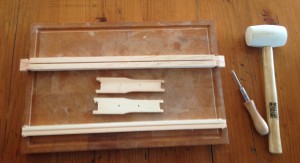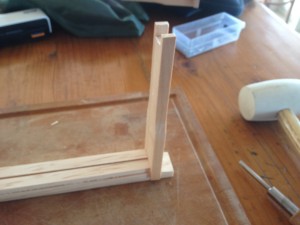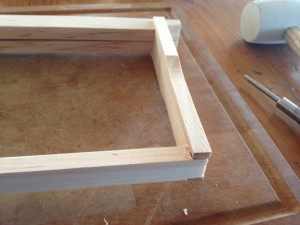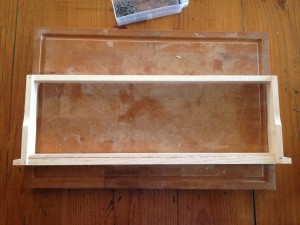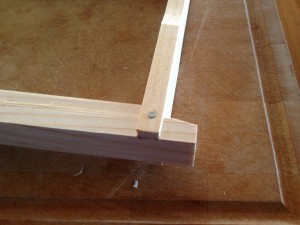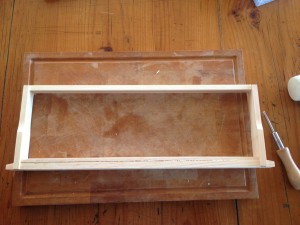I’ve had quite a few beekeepers ask me why I don’t build my own hives. While I’m not carpenter, I can muddle through the basics, as long as nothing has to look good or stay vertical for more than a few days, but building a hive from scratch is a bit edgy for me. But I will say, regardless of how much spare time you have, assembling hive frames can save you some cash and is very easy to do.
You see, hive components can be purchased unassembled, meaning all the wood has been cut and sanded, but just hasn’t been nailed together. So if you can swing a hammer, you can assemble a hive and save yourself some real money in the end. And besides, sometimes it just feels good to hit something with a hammer, doesn’t it?
While you can buy any hive part unassembled, I’m going to focus on frames as they’re easy to assemble and can often be half the cost. Now since a frame shouldn’t cost more than $2.00 each, saving a buck doesn’t seem like a windfall, but let’s remember that in an 8 frame hive, that’s $8 a box, and you’ll probably have three or four boxes. Pretty soon you’ve saved enough for that bottle of calvados you’ve been eyeing.
So let’s take a look at what you get when you buy frames unassembled and the tools you’ll need to get things going. At the left is a picture of the four parts in each frame, an upholstery pin push, and a mallet.
Note the pin push is just what I used instead of a hammer, as the nails are small, and my hands rather clumsy around small parts. The white mallet is only white because that’s what I had – the color doesn’t matter. Oh, and the strange cutting board underneath is so I don’t mar my dining room table. You don’t think I assembled these outside in the cold without a cocktail did you?
In this first picture, I have the first two pieces pushed together – the top bar which is the widest piece, now upside down on the cutting board, and the side bar stuck vertically into it. With most frames, there’s only one way these go together, so if it’s not even close to fitting together, you’ve got the wrong end – flip it over. Note I don’t have any nails in yet. These two pieces are held together due to their snug fit. The nails come later.Also note that my top bars have a groove in them which you can see in the picture, but all top bars don’t looks like this. These are a popular type, but yours may not have the groove. Same for the bottom bar.
Now put on the bottom bar. Again, the wood just pushes together and fits snugly. Do the same for the left side of the frame, attaching the vertical bar and pushing it together toform the square “frame” shape.
Now take the mallet and pound in each joint. We’re about to start to nail the frame parts together, so we need to make sure the wood pieces are seated firmly. A few gentle taps should be all it takes. If you don’t use a rubber mallet, and use a regular metal hammer instead, be gentle. These frames are just made to hold the weight of some honey and bees, so If you hit them hard with metal hammer, you’ll end up with match sticks.
If all went to plan, you should have an assembled frame, but no nails to hold it together. And yes, you need the nails, as I guarantee these frames will fall apart without them. You could also just glue them together, but who wants messy glue when you a few small nails will do the trick.
Now using the pin push, or a small hammer, drive a nail, in this case a small brad, though the side of the joint so that is holds the two wooden part together. I’d recommend putting another brad in the other side of the joint as well, so that you have two brads in each joint – one on each side.
Make sure you put brads on each of the four joints on the corners, and put a brad on each side. At that point, each join will be very secure.
The size of the brad is a judgment call, but I’d use something about 3/4 of an inch long. Shorter than that and it may wiggle loose, and longer than that and it will stick out the other side of the wood when you push it in. You don’t any fancy brads – the genetic steel variety from the hardware store should do. They don’t need to be stainless steel or be outdoor rated as the bees will just cover them with propolis anyway.
That’s it! You’ve now got a completed frame, and after you’ve done a few, you can put one together in about a minute. Good thing to, because with eight in a box, you’ll need to assemble about 32 before you put your tools away. But, first, reward yourself with a cocktail. That’s glass of calvados is calling…
Parts:
Wooden frames from http://www.aghall.com/beekeeping.html
Rubber mallet from Amazon
Upholstery tool: True Value Hardware. They have the nails too.


